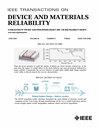PEDOT和ITO在热弯曲和循环应力下的比较分析:柔性太阳能电池的意义
IF 2.5
3区 工程技术
Q2 ENGINEERING, ELECTRICAL & ELECTRONIC
IEEE Transactions on Device and Materials Reliability
Pub Date : 2023-06-20
DOI:10.1109/TDMR.2023.3287800
引用次数: 0
摘要
聚(3,4-乙烯二氧噻吩)(PEDOT)和氧化铟锡(ITO)在电子器件中应用广泛,但它们在热应力下的稳定性是一个问题。PEDOT和ITO都容易受到热应力的影响,但它们的稳定性取决于暴露的温度和持续时间。为了确保长期稳定,必须使用适当的热管理技术和稳定的材料。ITO在拉伸和弯曲下具有良好的机械稳定性,而PEDOT可以承受高应变。柔性太阳能电池处于加热-冷却循环中,当薄膜和衬底以不同速率膨胀时,会产生由热失配引起的残余应变。ITO被大量用于柔性太阳能电池,但铟很稀缺,预计将在50年内用完。PEDOT是替代ITO的候选材料,目前正在深入研究中。比较了PEDOT和ITO在热弯曲和循环应力作用下的热稳定性。为了探讨不同因素对薄膜电特性的影响,采用DOE (design of experiments)工具进行数据采集,并采用方差分析方法对数据进行分析。结果表明,PEDOT在循环弯曲载荷下的稳定性优于ITO,而ITO在热应力下的稳定性略优于PEDOT。这些发现为PEDOT和ITO在热应力下的行为及其在电子器件中的潜在应用提供了新的见解。本文章由计算机程序翻译,如有差异,请以英文原文为准。
Comparative Analysis of PEDOT and ITO Under Thermal Bending and Cycling Stresses: Implications for Flexible Solar Cells
Poly(3,4-ethylenedioxythiophene) (PEDOT) and Indium Tin Oxide (ITO) are widely used in electronic devices, but their stability under thermal stress is a concern. Both PEDOT and ITO are susceptible to thermal stress, but their stability depends on the temperature and duration of exposure. To ensure long-term stability, it is essential to use appropriate thermal management techniques and stable materials. ITO has good mechanical stability under stretching and bending, while PEDOT can withstand high strains. Flexible solar cells are exposed to heating-cooling cycles, and when the thin film and substrate expand at different rates, residual strains caused by the thermal mismatch occur. ITO is heavily used in flexible solar cells, but indium is scarce and expected to run out within 50 years. PEDOT is a candidate to replace ITO and is currently under intensive research. This paper compares the thermal stability of PEDOT and ITO under thermal bending and cycling stress. In order to investigate the significance of different factors on thin film electrical characteristics, the DOE (design of experiments) tool was used for data collection and analysis of variance was used to analyze the data. The results showed that PEDOT is better than ITO under cyclic bending loading, while ITO is slightly more stable than PEDOT under thermal stress. These findings provide new insights into the behavior of PEDOT and ITO under thermal stress and their potential applications in electronic devices.
求助全文
通过发布文献求助,成功后即可免费获取论文全文。
去求助
来源期刊

IEEE Transactions on Device and Materials Reliability
工程技术-工程:电子与电气
CiteScore
4.80
自引率
5.00%
发文量
71
审稿时长
6-12 weeks
期刊介绍:
The scope of the publication includes, but is not limited to Reliability of: Devices, Materials, Processes, Interfaces, Integrated Microsystems (including MEMS & Sensors), Transistors, Technology (CMOS, BiCMOS, etc.), Integrated Circuits (IC, SSI, MSI, LSI, ULSI, ELSI, etc.), Thin Film Transistor Applications. The measurement and understanding of the reliability of such entities at each phase, from the concept stage through research and development and into manufacturing scale-up, provides the overall database on the reliability of the devices, materials, processes, package and other necessities for the successful introduction of a product to market. This reliability database is the foundation for a quality product, which meets customer expectation. A product so developed has high reliability. High quality will be achieved because product weaknesses will have been found (root cause analysis) and designed out of the final product. This process of ever increasing reliability and quality will result in a superior product. In the end, reliability and quality are not one thing; but in a sense everything, which can be or has to be done to guarantee that the product successfully performs in the field under customer conditions. Our goal is to capture these advances. An additional objective is to focus cross fertilized communication in the state of the art of reliability of electronic materials and devices and provide fundamental understanding of basic phenomena that affect reliability. In addition, the publication is a forum for interdisciplinary studies on reliability. An overall goal is to provide leading edge/state of the art information, which is critically relevant to the creation of reliable products.
 求助内容:
求助内容: 应助结果提醒方式:
应助结果提醒方式:


